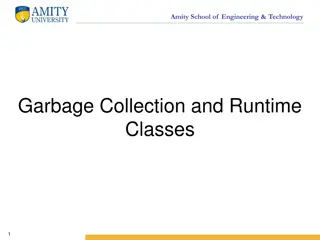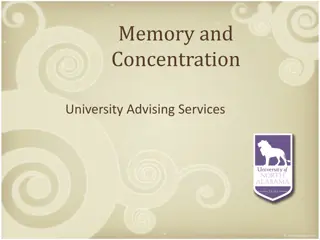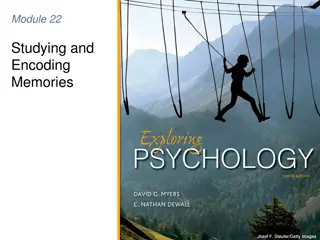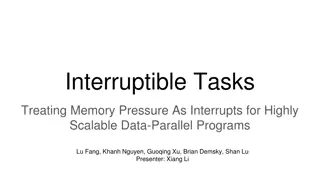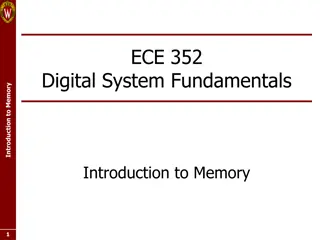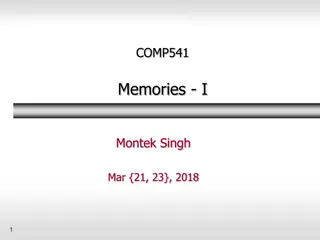
Memory: Processes and Models Explored
Delve into the complex world of memory as we recap its basics, explore the multi-store memory model by Atkinson & Shiffrin (1968), understand the importance of memory, and break down key processes like encoding, storage, and retrieval. Discover the different types of memory such as Short Term Memory (STM), Long Term Memory (LTM), and Sensory Memory. Unravel how early cognitive psychologists outlined the memory process and the significance of models in comprehending memory systems.
Download Presentation

Please find below an Image/Link to download the presentation.
The content on the website is provided AS IS for your information and personal use only. It may not be sold, licensed, or shared on other websites without obtaining consent from the author. If you encounter any issues during the download, it is possible that the publisher has removed the file from their server.
You are allowed to download the files provided on this website for personal or commercial use, subject to the condition that they are used lawfully. All files are the property of their respective owners.
The content on the website is provided AS IS for your information and personal use only. It may not be sold, licensed, or shared on other websites without obtaining consent from the author.
E N D
Presentation Transcript
Aims for lesson 1 Recap on what we know about memory Introduce Multi-Store Memory Model (Atkinson & Shiffrin, 1968) Introduce the Sensory Store Learn about the Sperling study
Definition Memory is the term given to the structures and processes involved in the storage storage and subsequent retrieval of information information This information can include facts, experiences, skills or habits retrieval of Memory is the means by which we draw on our past experiences in order to use this information in the present
Why is memory important? Clive Wearing Case study: Clive Wearing - Strengths? - Weaknesses?
Memory is broken down into three key processes Encoding Storage Retrieval
Encoding this refers to how we input that we can make sense of it Storage- this is how how information is stored be used at a later time input sensory information so stored into your memory to Retrieval refers to the ability to recover storage recover information information from Reintegration: Reintegration: When you construct a memory using cues Recall Recall The ability to retrieve stored information. Recognition: Recognition: When you know something is familiar
There are two main types of memory Short Term Memory (STM) Long Term Memory (LTM) Research indicates an additional type of memory: Sensory Memory
Multi-Store Model (Atkinson & Shiffrin, 1968) Outlines how early cognitive psychologists describe the process of memory As memory is intangible a model is used to helps us understand the system of how the memory works Research is conducted and evidence used to test the assumptions assumptions of a model The model is then either supported, updated or refuted
What psychologists are interest in is. Encoding the form stored form in which the information is Capacity how much how much information can be stored Duration how long how long information can be stored for
Basic structure to the Multi-Store Model Atkinson & Shiffrin (1968) Image result for short term memory process
Sensory register - encoding Information is gathered by the senses and enters the sensory register All information must must go through this stage Information is stored in raw, unprocessed form with separate sensory stores for different sensory inputs ECHOIC MEMORY : auditory input from the ears things you HEAR. Stored as sounds. ICONIC MEMORY : visual info from the eyes things you SEE. Stored as images. How its stored according to the sensory inputs Top tip: E Echoic = choic = E Ear ar Top tip: Iconic Iconic = EYEconic EYEconic
Sensory register a brief store for sensory information brief If attended to, it will pass onto the STM If not attended to, it will fade quickly leaving no lasting impression Image result for short term memory process
Sensory register - capacity The capacity for each sensory memory store in the sensory register is very large very large Information is unprocessed unprocessed and highly detailed detailed
Sensory register - capacity The next slide demonstrates your iconic sensory memory at work Keep your eyes fixed on the slide and concentrate It will flash on and off quickly try to remember everything on it. When you see the smiley face write everything down
7 1 V F X L 5 3 B 4 W 7
Sensory memory capacity continued This was based on an experiment Sperling (1960 Sperling (1960) ) Aim: to investigate sensory register memory store Procedure: Part 1: Participants presented with grid for less than 1 second and asked how many letters they could remember
Findings: First instance, people were able to recall 4-5 letters from the whole grid Sperling s ppts claimed that they could see more than the four items reported, but they could not report all of them because the array seemed to disappear as time passed
P Part 2: art 2: Before shown grid, ppts told a particular tone will follow the grid and this will be the row in which they will recall (high tone = top row, medium tone = middle row, low tone = bottom row) The tone was presented at the same time the letters were shown (remember the grid was shown for less than 1 sec!) This allows ppts to focus enough to take in the specific row Sperling found that as long as the tone was sounded within a quarter of a second of the flash, ppts could report 3 out of 4 items on the row indicated Because the row selected was random, it assumes the ppts would be able to recall 75% of the total
What does this mean?? In one ear and In one ear and out the other out the other The capacity is large However, , the duration large duration is small . Echoic memory (2 seconds) lasts longer than Iconic memory in the sensory register (0.5 seconds) Different sensory stores have different capacities and there is some evidence that duration decreases with age The short duration of SM makes it difficult to test. As soon as a person starts writing, the memory trace has faded
Task 2 140 characters or less 1. Describe the procedure 2. Describe the findings procedure of Sperling (1960) findings of Sperling (1960) Important: Important: Please ensure to include all the important information
Evaluation of Sperling (1960) One weakness of the study is that it was conducted in a laboratory environment. This means there were high levels of control. Due to the artificial nature of the study, the results lack ecological validity. This means the findings cannot be generalised to a real life setting
Evaluation of Sperling (1960) On the other hand, the artificial nature of the study allows the study to be replicated easily. In addition to this, the use of a laboratory environment allows for extraneous and independent variables to be controlled for. This allows for a cause and effect relationship to be established between the IV and the DV
Evaluation of Sperling (1960) One strength of the study was the use of repeated measures design. This meant each participant took part in each condition This eliminates participant characteristics from influencing results
Evaluation of Sperling (1960) However, on the other hand, this allows for order effects. This is where the participants may become tired, bored or fed up by the second condition. This may have worsened their performance. Additionally, this may have led to practice effects where the participants performance is enhanced as they have saw the letters before.
Evaluation of Sperling (1960) Finally, this study falls short as it uses a random set of letters to test memory. The use of a random set of letters is uncommon in everyday life to remember. It lacks meaning to the participants. This is called mundane realism
Task 3: Jigsaw learning Part 1: Write as much as you know about your section Part 2: All the number 1 s sit together and share all the information they know about their section 2 s, 3 s and 4 s) (Same for Part 3: Go back to your normal seats and share your information with those around you. For example, if you are a 1, share all your information with the 2, 3 and 4 sitting next to you







